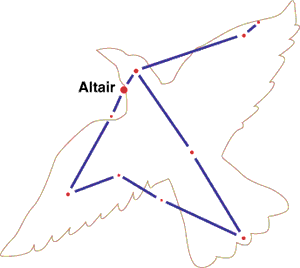It's time for part three of the constellation series, and this time I'm tackling a constellation I had never heard of before: Aquila. It's one of the medium sized constellations, located a little 'above' Sagittarius.
Aquila is aptly named 'the eagle'. The shape it was given, as well as the mythology attached to it all relate to the bird. Aquila is the Latin for 'eagle', and from mythology, we are well aware that Zeus's favorite animal is this very bird.
This constellation is heavily linked to the constellation of Aquarius: the water carrier. This constellation is often said to represent Ganymēdēs, who was carried to Olympus by an eagle; this very eagle, in fact. It is also said that Zeus's thunderbolts are carried down by the eagle. In the Odysseia, Odysseus' son Telemachos receives oracular message from Zeus by way of the eagle:
For all his hard work, the eagle was placed into the sky by Zeus, so it could soar through the skies for eternity. The constellation Aguila is visible at latitudes between +90° and −75°. It is best visible at 21:00 (9 p.m.) during the month of August.
This constellation is heavily linked to the constellation of Aquarius: the water carrier. This constellation is often said to represent Ganymēdēs, who was carried to Olympus by an eagle; this very eagle, in fact. It is also said that Zeus's thunderbolts are carried down by the eagle. In the Odysseia, Odysseus' son Telemachos receives oracular message from Zeus by way of the eagle:
"So Telemachus spoke, and Far-Seeing Zeus sent out two eagles from a high mountain peak. They flew for a while with outspread wings, side by side in the currents of air, but when they were above the voice-filled assembly they swiftly slanted their wings, circling round, gazing down on the heads below, and death was in their gaze. Then they clawed at each other’s head and neck with their talons, and soared away eastward over the roofs of the town. The people saw them and wondered, and considered what this might foreshadow. Then the old hero Halitherses, Mastor’s son, spoke out, for he was the wisest man of his day in bird-lore and prophecy. With goodwill in his heart he addressed the assembly:
‘Men of Ithaca, listen to me: and I say these words to the Suitors especially, since disaster approaches them. Odysseus will not be far from his friends much longer, and I believe even now he is near, sowing the seeds of dark death for all these men. Yes, and he will bring trouble to many another of us, who live in clear-skied Ithaca. Let us think in advance how we might prevent all this, or let them prevent it of their own accord, easily their best option. I am not unskilled in prophecy, but have true knowledge. I say that all things for that man will be fulfilled, just as I told him when the Argives sailed for Troy, he among them, resourceful Odysseus. I declared that, suffering many troubles, losing all comrades, he would return in the twentieth year, unknown to all: and now it is coming to pass.’"
Another prominent myth in which the eagle of Zeus features is the myth of Prometheus, who stole fire from the Gods and gave it to humanity. For his efforts, he was tied to a rock by Hermes who was under orders from Zeus. Zeus then tormented him every day for the longest time, by sending an eagle to peck out his liver again and again, because as an immortal, Prometheus' liver grew back every night. In some stories, Prometheus is eventually freed by the hero Hēraklēs, after Zeus takes mercy on him.
For all his hard work, the eagle was placed into the sky by Zeus, so it could soar through the skies for eternity. The constellation Aguila is visible at latitudes between +90° and −75°. It is best visible at 21:00 (9 p.m.) during the month of August.
-
Monday, October 1, 2012
astronomy Constellation series Ganymēdēs Hēraklēs Mythology 101 Odysseia Odysseus Prometheus Ptolemy Telemachos Zeus


No comments:
Post a Comment